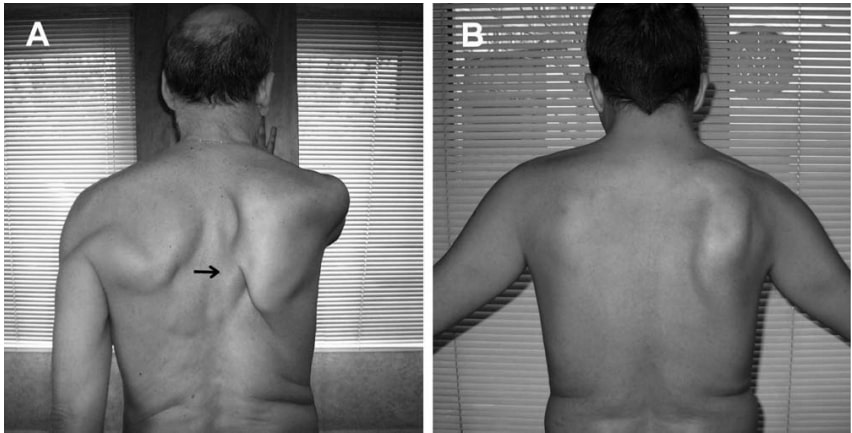Scapular Winging: Difference between revisions
From WikiMSK
mNo edit summary |
|||
| Line 1: | Line 1: | ||
The most common cause of winging is long thoracic nerve palsy (serratus anterior weakness), usually from neuralgic amyotrophy. The second most common cause is spinal accessory nerve palsy (trapezius weakness). | |||
== Aetiology == | == Aetiology == | ||
The causes of unilateral winged scapula in a study of 128 patients were<ref name=":0">Seror P, Lenglet T, Nguyen C, Ouaknine M, Lefevre-Colau MM. Unilateral winged scapula: Clinical and electrodiagnostic experience with 128 cases, with special attention to long thoracic nerve palsy. Muscle Nerve. 2018 Jun;57(6):913-920. doi: 10.1002/mus.26059. Epub 2018 Feb 24. PMID: 29314072.</ref>: | The causes of unilateral winged scapula in a study of 128 patients were<ref name=":0">Seror P, Lenglet T, Nguyen C, Ouaknine M, Lefevre-Colau MM. Unilateral winged scapula: Clinical and electrodiagnostic experience with 128 cases, with special attention to long thoracic nerve palsy. Muscle Nerve. 2018 Jun;57(6):913-920. doi: 10.1002/mus.26059. Epub 2018 Feb 24. PMID: 29314072.</ref>: | ||
* Long thoracic nerve palsy (54%) | * Long thoracic nerve palsy (54%), of which 87% were due to neuralgic amyotrophy | ||
* Spinal accessory nerve palsy (30%) | * Spinal accessory nerve palsy (30%) | ||
* Both long thoracic and spinal accessory nerve palsy (4%) | * Both long thoracic and spinal accessory nerve palsy (4%) | ||
| Line 11: | Line 11: | ||
* Voluntary (5%) | * Voluntary (5%) | ||
* No definitive cause (2%) | * No definitive cause (2%) | ||
Neuralgic amyotrophy is a common underlying cause. This is an acute painful monophasic neuropathy with unique or multiple nerve lesions. Clinical features are weakness, amyotrophy, and sensory loss in an asymmetric and patchy distribution, mainly involving the upper limbs. Cervical MRI is normal.<ref name=":0" /> | |||
== Clinical Patterns == | == Clinical Patterns == | ||
Revision as of 07:26, 20 August 2021
The most common cause of winging is long thoracic nerve palsy (serratus anterior weakness), usually from neuralgic amyotrophy. The second most common cause is spinal accessory nerve palsy (trapezius weakness).
Aetiology
The causes of unilateral winged scapula in a study of 128 patients were[1]:
- Long thoracic nerve palsy (54%), of which 87% were due to neuralgic amyotrophy
- Spinal accessory nerve palsy (30%)
- Both long thoracic and spinal accessory nerve palsy (4%)
- Facioscapulohumeral dystrophy (4%)
- Orthopaedic causes (9%)
- Voluntary (5%)
- No definitive cause (2%)
Neuralgic amyotrophy is a common underlying cause. This is an acute painful monophasic neuropathy with unique or multiple nerve lesions. Clinical features are weakness, amyotrophy, and sensory loss in an asymmetric and patchy distribution, mainly involving the upper limbs. Cervical MRI is normal.[1]
Clinical Patterns
| Long Thoracic Nerve Palsy | Spinal Accessory Nerve Palsy | |
|---|---|---|
| Classical physical signs | ||
| Muscle palsy and signs on inspection | Serratus anterior atrophy of digitations | Trapezius atrophy of lower and upper fibres |
| Side involved | Right side is 88% | Random |
| Position of scapula when winged | Medial, near the spine | Lateral, away from the spine |
| Movement that brings on or enhances winging | Forward flexion with pushing on a wall or pull ups | Abduction with external rotation against resistance |
| Additional physical signs | ||
| Ropelike lower trapezius | Raised by the medial margin of scapula and descends toward the lower thoracic vertebrae. Best seen with anterior elevation of 95-120° | Never seen because the lower trapezius is atrophied |
| Ropelike rhomboid major | Never seen because the rhomboids are masked by the normal trapezius | Rises from the inferior angle of the scapula towards the upper thoracic vertebrae, best seen at rest or near rest |
| Abrupt sliding of the scapula during lateral elevation | Never seen | Occurs with lateral elevation of at least° |
References
- ↑ 1.0 1.1 1.2 Seror P, Lenglet T, Nguyen C, Ouaknine M, Lefevre-Colau MM. Unilateral winged scapula: Clinical and electrodiagnostic experience with 128 cases, with special attention to long thoracic nerve palsy. Muscle Nerve. 2018 Jun;57(6):913-920. doi: 10.1002/mus.26059. Epub 2018 Feb 24. PMID: 29314072.


